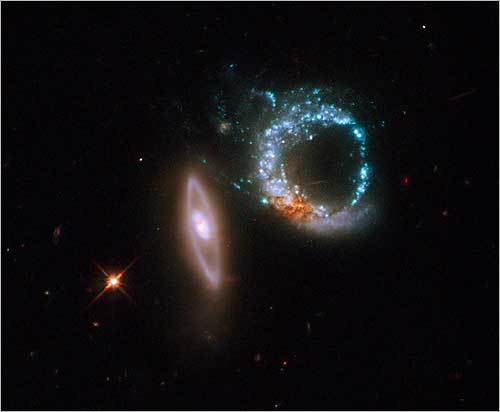
From the W.M. Keck Observatory site tonight ~
ASTRONOMERS CAPTURE FIRST IMAGES OF NEWLY-DISCOVERED SOLAR SYSTEM
Kamuela, HI (November 13th, 2008) Using high-contrast, near-infrared adaptive optics observations with the Keck and Gemini telescopes atop Mauna Kea, astronomers for the first time have taken snapshots of a multi-planet solar system, much like ours, orbiting another star.
The new solar system orbits the dusty young star named HR8799, which is 140 light years away and about 1.5 times the size of our sun. Three planets, roughly 10, 10 and 7 times the mass of Jupiter, orbit the star. The sizes of the planets decrease with distance from the parent star, much like the giant planets do in our system.
And there may be more planets out there that scientists just haven't seen yet.
Astronomers have known for over a decade that there are planets orbiting other stars by watching the light output of certain stars – when they would briefly dim, it was supposed the reason was because a planet or other orbiting object had just passed in between it and us. In some ways, planetary system HR8799 seems to be a scaled-up version of our own solar system orbiting a larger and brighter star. The host star is a bright blue A-type star, which is also young – less than 100 million years old. This means its planets are still glowing with heat from their formation.
The planets have been extensively studied using adaptive optics on the giant Keck and Gemini telescopes in Hawaii (the one place in Hawaii that I would have loved to visit but only glimpsed high up on the summit of Mauna Kea from back down by the ocean at Waikoloa). Adaptive optics on these enormous telescopes (the largest ground-based telescopes in the world) enable astronomers to minimize the blurring effects of the Earth's atmosphere and produce images with unprecedented detail and resolution. An advanced computer processing technique is then used to extract detail from the dim planets orbiting this vastly brighter star HR8799. What is so amazing about this optical system is that it was conceived back in 1953 but could not be realized until the 1990s when computer technology had finally caught up to the human mind that envisioned it.
There is a high probability that there are more planets in this distant solar system. What is remarkable about this system from others discovered is that its giant planets lie in the outer parts like in our solar system and so it has 'room' for possible smaller, terrestrial planets closer to the star which are still beyond our current ability to see.
As an astronomer on one of the two teams that was able to take the first images says ~
"It's only a matter of time before we get a dot that's blue and Earthlike."

No comments:
Post a Comment